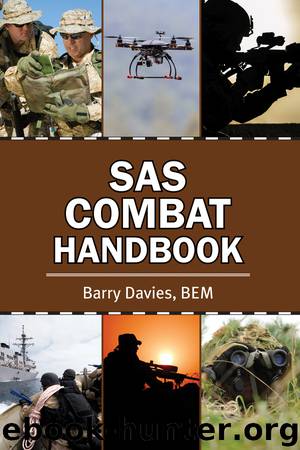SAS Combat Handbook by Davies Barry

Author:Davies, Barry
Language: eng
Format: epub
Publisher: Skyhorse Publishing
Published: 2014-12-31T16:00:00+00:00
Aircraft hijacking requires a knowledge of where to gain entry from the outside of an aircraft.
The size of the aircraft involved and the number of passengers onboard will dictate how many entry points the team needs to breach in order to make a successful entry. Almost all aircraft doors, both normal passenger and emergency, can be opened from the outside of the aircraft while it is on the ground. This is a design element which facilitates emergency services access in the event of accident, crash or other emergency.
Most aircraft, especially the larger types, require that the assaulting team be elevated several meters in order to gain access. A wide variety of ladder systems are available to the assaulting team, and these can be adjusted to reach any type of aircraft door. In some cases, two ladders are used side by side and placed against the aircraft fuselage. The idea is that the first man operates the handle and uses his body weight to swing the door open. This technique normally requires two hands and blocks the view of that particular team member; however the second member is free to fire or enter the moment the door is ajar. Ladders are also used to gain access to the wings, whereupon the emergency doors can be opened.
Until recently, stealth has been the most popular method of assaulting hijacked aircraft. However, many anti-terrorist teams now favor a rapid-response vehicle. This vehicle has a preassembled platform system attached which can be adjusted to any height. The result is a modern mobile siege tower which transports the assaulting members at the correct elevation directly to the aircraft entry points. While the vehicles can still take advantage of the blind area at the rear of the aircraft, they also offer a rapid delivery. It is incumbent on the team commander to get all his men onto the aircraft in order to facilitate a good assault; therefore the vehicle is normally armored.
It is not possible to give details of all types of aircraft, as there are so many sizes and variations. However, my personal plan to assault flight LH181 while on the ground in Dubai is a good example.
The Boeing 737 is a simple little animal where anti-terrorist drills are concerned. There are only three options for entry: tail, wing, and front catering area. I thought that if the terrorists began to carry out any threatened shootings, they would naturally take the precaution of covering the main doors. It seemed less likely that they would cover the two emergency exit doors leading to the wings, so the plan that basically fell into shape was to attack through these. The fact that the wing emergency exits were designed to be easily opened from the outside was another strong factor for us adopting this mode of attack—and there were others. The German anti-terrorist team, the GSG9 (Grenzschutzgruppe 9), had also discovered a blind spot where the wing joins the aircraft body. Two men could sit beneath the emergency doors and not be visible from any of the windows.
Download
This site does not store any files on its server. We only index and link to content provided by other sites. Please contact the content providers to delete copyright contents if any and email us, we'll remove relevant links or contents immediately.
Shoe Dog by Phil Knight(4899)
The Rules Do Not Apply by Ariel Levy(4530)
Walking by Henry David Thoreau(3685)
Running Barefoot by Amy Harmon(3338)
I'll Give You the Sun by Jandy Nelson(3275)
How to Read Water: Clues and Patterns from Puddles to the Sea (Natural Navigation) by Tristan Gooley(3244)
Crazy Is My Superpower by A.J. Mendez Brooks(3208)
How to Read Nature by Tristan Gooley(3083)
How Music Works by David Byrne(2968)
The Boy, the Mole, the Fox and the Horse by Charlie Mackesy(2832)
The Fight by Norman Mailer(2709)
Seducing Cinderella by Gina L. Maxwell(2546)
Cuba by Lonely Planet(2490)
Accepted by Pat Patterson(2219)
Going Long by Editors of Runner's World(2216)
The Unfettered Mind: Writings from a Zen Master to a Master Swordsman by Takuan Soho(2160)
The Happy Runner by David Roche(2125)
Backpacker the Complete Guide to Backpacking by Backpacker Magazine(2111)
Trail Magic by Trevelyan Quest Edwards & Hazel Edwards(2064)
